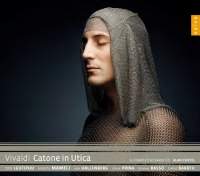Texte paru dans: / Appeared in: |
|
|
Reviewer: Simon Heighes I thought I’d go the extra mile for this one . . . in fact all the way to Italy , to examine Vivaldi’s autograph manuscript of Catone in Utica in the National Library of Turin. It now forms part of the Foà-Giordano collection, presented by two wealthy families (in memory of their young sons) in the late 1920s. These bequests finally reunited two halves of a unique and invaluable library — Vivaldi’s own personal archive of scores. There are over 450 works, sacred and secular, including all but one of Vivaldi’s 20 or so surviving operas. Most importantly, the majority of these manuscripts are in Vivaldi’s own hand, some in his beautiful scribal writing but also many first drafts and ‘working copies’, bristling with re-writes and revisions, which offer extraordinary insights into his working methods. Vivaldi’s manuscripts are also overflowing with his meticulous performing instructions ornamentation, dynamics, articulation, bowing eyen fully written-out cadenzas. For years these manuscripts provided a private playground for scholars, but in 2000 Naïve founded its Vivaldi Edition — an ambitious, long-term project to systematically explore and record the entire Turin collection for a wider public. Gradually this series has revealed a very different Vivaldi from the one we thought we knew. Vivaldi certainly wrote a lot of concertos and some excellent church music, but it’s now clear that it was the opera house that dominated his career. Indeed, together with Alessandro Scarlatti, Vivaldi was one of the most important and prolific opera composers of the late Baroque. He claimed to have penned 94 operas, though modern scholars have tactfully reduced this to between 50 and 70. So, back to Catone — preserved in Volume 38 of the Foà Collection. It’s on the desk in front of me, giving off the subtlest aroma of ancient pasta, its pages offering crisp resistance to my turns, and the writing betraying the rapier-like strokes of Vivaldi’s white-hot quill . . . and sometimes the heavy note-heads of midnight slog. There’s so much of Vivaldi himself in these pages it’s hard to concentrate on the music. But I’ve noticed that there appears to be rather less of this opera than there should be. Rather alarmingly the manuscript of Catone begins with Act 2. I check . . . no, nothing in Volume 37, or anywhere else in fact. All that survives of Catone in Utica - staged by Vivaldi in Verona in 1737 — are the last two acts. Vivaldi may never have written the first act; collaborative operas were quite common. But the surviving Veronese word book mentions only Vivaldi as the composer, and a single aria from Act I seems to have been reused by him the following year in his opera Rosmira. Well, that’s one aria down six more to find. But the solution adopted here lies not in detective work, but in re composition - a task undertaken by the Italian musicologist Alessandro Ciccolini. He’s rejected the usual method of supplying such missing music — which is simply to take suitable arias from Vivaldi’s other operas and fiddle with them until the words of the missing aria finally fit. Since Vivaldi often did something similar himself, this method has its merits. But in this case, Ciccolini wanted to explore another quick compositional technique used by Vivaldi, which involved delying into his concertos for inspiration. Ciccolini meticulously documents his methods and sources in the CD booklet, and we learn that of the seven arias in Act 1, Ciccolini has recomposed four using material from Vivaldi’s concertos; one is loosely based on material from an aria from the opera La fida ninfa; one C follows an aria in Atenaide; and there is one surviving original aria which was later reused in Rosmira, from which it can be borrowed back. The opening Sinfonia is transferred straight from L’Olimpiade a typical Vivaldian short-cut. However, the recitatives have all had to be composed from scratch. I asked the conductor of this hybrid score, Alan Curtis, whether he really thought it was worth devoting 70 minutes (the whole of the first CD) to so much semi-Vivaldi. He was frank: ‘The simplest way I can put it is to say honestly that I do not feel any particular risk in the quality of the music when we progress from Act I to Act 2. If you care about the drama, for me, Act 1 is as necessary to a CD of an opera as it is to a performance of this opera in the theatre. I almost agree. Ciccolini’s new arias are very convincing indeed, especially those for Cesare; but when I first listened through to the opera not quite realizing the extent of the reconstructive surgery it vas only in the last two acts that picked up the remote control to repeat such glorious emotional effusions as ‘Nella foresta’, with its braying horns, ‘Se in campo’, with its belligerent trumpets, and the long, hushed ‘Se mai senti spirarti’ — nothing in Act I quite reaches these heights. I am also struck by just what excellent recitative Vivaldi writes in his two surviving acts. When I spoke to Finnish tenor Topi Lehtipuu, who sings the title role, he vas absolutely clear that ‘when it comes to Vivaldi’s approach to characterization, we get to know Catone better through his recitatives than his arias. They are so dramaticallv effective . . . there’s lots of subtle psychology at work. Curtis agrees: ‘in Catone Vivaldi’s recits are unusually good’, but he admits that ‘some of the arias are not particularly dramatic, and the ending is anti-climactic’. It’s true. Vivaldi grafted a rather contrived happy ending onto the plot, and the third act with just three arias and a short duet feels a little short. But even if a few of the arias — like Cesare’s parting shot ‘Sarebbe un bel diletto’ - seem weak in their dramatic context, they are nevertheless strong musically. The plot — very briefly -— the old Roman senator Catone’s resistance to the rise of Giulio Cesare. Catone flees to Utica with his daughter Marzia; Cesare follows, falls in love with Marzia, and in the ‘happy’ version of Metastasio’s libretto preferred by Vivaldi, Catone’s death is prevented and Cesare and Marzia marry. Initially, the opera was one of’ Vivaldi’s great success. ‘My opera is praised to the skies’, he vrote to the Marquis Bentivoglio, ‘and if God blesses the season to the end, there will he a profit, and not a negligible one.’ Much of the credit vas probably due to the excellent cast: a typical Vivaldi amalgam of cheapish, rising talent and trusted regulars who never asked for outrageous fees. The same is true for the current cast — which probably wasn’t cheap, but is certainly stellar. Lehtipuu, as Catone, is a dignified statesman in his first-act aria, but a furious father in his Act 2 ‘Dovea sevnarti allora’, where Letipuu really shows his teeth as he adds real tonal bite to the curses rained down on Marzia. She is sung by one of my favourite feisty Baroque contraltos - Sonia Prina. Good to hear her as a woman for a change - so often she takes alto castrato roles. Her enunciation - the way she masticates suitably onomatopoeic text — is as deliciously chewy as ever and she runs away with gleeful, gritty determination in the pithy ‘Se parto’. Ann Hallenberg is not really a newcomer anymore - she’s a regular in the Vivaldi Edition — but ‘should be so much better known, such her palpable emotional intelligence and utterly captivating tonal precision. As the scheming Emilia she sizzles in the climactic aria of Act 2, ‘Corne invano il mare irato’, relishing all the stormy sea imagery, and in the following act she banters bravely with a pair of hunting horns in ‘Nella foresta’ — bringing some much needed dramatic grit and ornamental glitter to the finale. However, it’s Roberta Mameli’s emotionallv comprehensive portrait of Giulio Cesare which wins top honours here. It helps that she gets some of the best music, even in Act I where she utterly changes her vocal tone to one of concentrated buttery-love-, sickness in Ciccolini’s ‘Apri le luci e mira’. Love for Marzia also dominates Mameli’s beautifully poised performance of the long ‘Se mai senti spirarti’, where hushed breezes are hinted at in muted and pizzicato strings, as Mameli’s lungs know no restrictions in her endlessly sustained and subtly nuanced phrases.
The cast is riveting in the recitatives. The singers are
so animated and involved in the drama you just have to find out what’s going
on by following the action (text and translation) in the accompanying
booklet. Curtis shapes the drama generously, with notably more spacious
speeds than some of his colleagues in earlier operas, and there’s no lack of
dramatic tension or excitement. Indeed, I love an exciting performance in
which, according to that favourite reviewer’s phrase, ‘the notes are really
lifted off the page’. Here, having seen the original notes myself, I can
honestly say that they were’ already in flight — such is the propulsive
energy of Vivaldi’s handwriting. How wonderful that this translate’s into a
truly uplifting performance.
|
|
|
|
|
|
Cliquez l'un ou l'autre
bouton pour découvrir bien d'autres critiques de CD |
|




